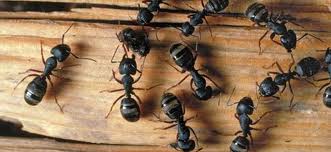Along with pavement ants and odorous house ants, carpenter ants are often cited by experts as being the most common ant pests of homes in the US. While pavement ants and odorous house ants are relatively difficult to control, they are merely nuisance pests, and neither of them inflict structural damage to homes. Unfortunately, this is not always the case with carpenter ants, as several carpenter ant species found throughout the country are well known for excavating nesting galleries within structural wood, resulting in costly damage. Carpenter ant damage to woodwork is particularly common in the northeast where the most common and destructive carpenter ant pest species, the black carpenter ant, is most abundant. While the majority of indoor carpenter ant infestations do not see workers initiate nests within woodwork, carpenter ants still inflict millions of dollars in property damage annually in the US. It is also important to remember that carpenter ants are not the only wood-infesting ant pest species, as acrobat ants, thief ants, larger yellow ants, and cornfield ants are all known to nest within both natural and finished wood sources.
With the exception of carpenter ants, the most significant ant pests of finished wood include acrobat, thief, and velvety tree ants. Velvety tree ants can only be found in the western US, but multiple acrobat ant and thief ant species are very common throughout the northeast. Just like carpenter ants, both of these species nest only within moist, and preferably, decayed structural lumber. Only a minority of acrobat and thief ant infestations see workers damage structural wood, but they readily establish nests within wall voids and other concealed indoor areas that cannot be easily accessed by pest control professionals. Ant pest species in the Lasius genus are often referred to as cornfield ants, citronella ants or moisture ants, and sources differ on the degree to which these ant pests damage finished wood in homes. In any case, most experts seem to agree that these ants rarely establish indoor nests, as workers generally enter homes from outdoor nests in order to seek sweet-tasting food sources. All of these ants, particularly Lasius species and larger yellow ants, usually nest within structural wood members that have already been partially hollowed out by previous wood-infesting pests, namely termites and carpenter ants. So while these ants may nest within structural lumber on occasion, they rarely inflict damage.
Have you ever encountered structural wood that had sustained damage from wood-infesting insect pests?

